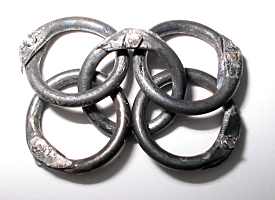Traveling within the World
Linking your favorite traveling artists across the globe
Viking Age Arms and Armor Viking Mail
|
Mail is a protective iron fabric made up of thousands of interlocking iron rings. In the Viking era, mail was always made with a 4-in-1 pattern, in which each ring passes through its four nearest neighbors. (The photo to the left shows a modern reproduction.) |
During the Viking age, mail usually was worn in the form of a mail shirt (brynja), like the reproduction shown to the right. Typically, the garment was T-shaped, with short sleeves (half to three-quarters length) and thigh length. (Anything longer would make it difficult to ride a horse.) The reproduction mail shirt shown in the photo weighs about 12kg (26lbs). The weight is not particularly burdensome, since a lot of the weight is taken up on the hips by the belt. Regardless, the stories say that sometimes raiders left their mail shirts on board ship when they went raiding, so they wouldn't be weighted down. In chapter 82 of Haralds saga Sigurðarsonar, the author relates that on the day of the battle at Stamford Bridge, it was a day with hot sunshine, and the Norwegians left their mail shirts behind, on board ship. |
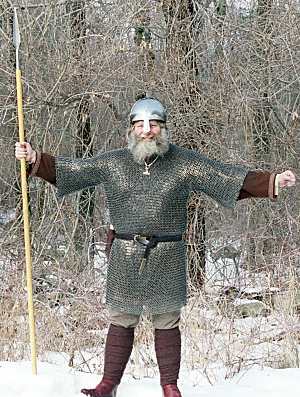 |
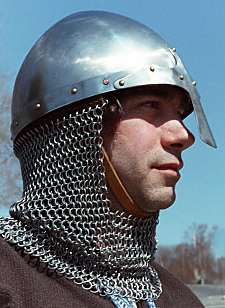 |
The 12kg of iron in a mail shirt represented a treasure in the Viking age. Few people could have afforded that much iron. Thus, mail shirts must have been very rare. Anyone who could have afforded one would certainly have wanted one, but probably few people could afford one. Someone who couldn't afford a mail shirt might have used smaller pieces of mail to protect the more vulnerable parts of the body. The reproduction helmet shown to the left has a mail curtain that protects the most vulnerable part of the neck from cuts. It provides significant protection while using only a fraction of the iron of a full mail shirt. |
In order to make mail, a smith started with an iron bar, which he drew into iron wire by drawing it repeatedly through smaller and smaller openings in a drawplate. A 10th century drawplate from Norway is shown to the right, which is about 15cm long (6in). |
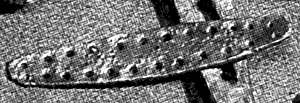 |
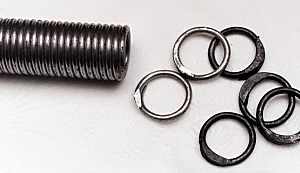 |
The wire was wound around a wooden form to create a coil of iron wire. The coil was split down its length to create a number of open iron rings. (In the photo to the left, the brighter rings have just been cut from the coil, while the darker rings have been annealed and are ready for the next step.) One by one, each ring was passed through neighboring rings to form the fabric of the shirt, then closed and sealed shut with a rivet. This process was repeated again and again, thousands and thousands of times to make up the fabric of the shirt. The reproduction mail shown in the photo above is made from about 30,000 rings. |
Some samples of mail from the Viking age are made up entirely from riveted rings, like the reproduction mail shown above. Most samples, however, have alternating riveted and solid rings, such as the 10th century mail from Gjermundbu, shown to the right. |
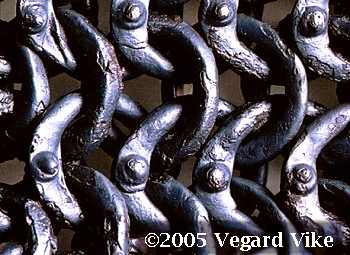 Photo by Vegard Vike |
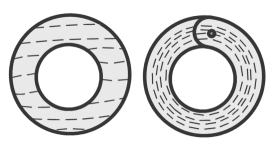 |
The orientation of the slag intrusions in the rings (left) suggests that the solid rings were punched out of sheet metal, while the riveted rings were made from drawn wire. The square cross section of the solid rings provides further evidence that the rings were punched. |
Most samples of Viking age mail use round rivets, such as the Gjermundbu mail shown above. The smooth, unfaceted shape of the Gjermundbu rivet heads suggests that a setting tool was used to set the rivets.
Some researchers have proposed that the solid rings were made by welding shut open rings. The archaeological evidence tends not to support this hypothesis.
Regardless of how it was accomplished, the rings of mail were made solid. Links which were simply bent into shape and butted together without a means to hold them shut were not strong enough to stand up to the rigors of combat.
The rings were made into panels of manageable size and weight, before being linked together to make the final garment. As the panels were linked, alterations to the 4-in-1 pattern were made to shape the fabric to the contours of the body and to provide freedom of motion in places such as under the arm. Rings were dropped or added to rows as needed to shape the finished fabric.
During the Viking age, the diameter and gauge of the wire rings varied considerably. The photo to the right shows the sleeve of a 13th century mail shirt, which uses finer wire and smaller rings than either the modern reproduction or the Gjermundbu mail shown above. All three, however, are in the range of wire and ring diameters that were used in the Viking age. The diameter of the rings in the Gjermundbu shirt average 8mm (0.3 in), and the wire diameter averages 1.2mm (0.05 in, about 16 gauge). |
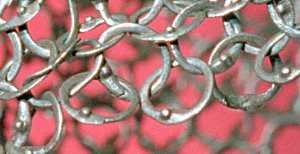 |
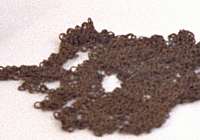 |
Little mail survives from the Viking era. Underground or underwater, the thin rings corrode very quickly. Most mail from the period survives as a rusty pile of junk. The mail shown to the left was found in Sveinsströnd in Iceland and is better preserved than most. Originally thought to be from the 10th century, it has more recently been dated from the 13th century or later. The one more or less complete Viking age mail shirt (from Gjermundbu) was in many pieces when found. Numerous sections were corroded into a solid mass. Some of the rings survived only as a hollow corroded shell. |
In the stories, the word brynja is usually translated as "mail shirt". In a few instances, the word spangabrynja is used, usually translated as "plate-mail", such as in chapter 5 of Grænlendinga þáttur. Whatever it might have been, the story says that Símon did not care for it, and he threw it to the ground as useless junk. One wonders if it might have been scale armor, which was not in common use during the Viking age and which may have been brought into the Norse lands by foreign visitors.
It's important to note that mail does not provide a complete defense; mail is only a secondary defense. If one were to draw the edge of a sword across the arm of an combatant wearing a mail shirt, the sword wouldn't bite; the mail would protect against a cut. However, if one were to take that same sword and strike a powerful blow against the arm or shoulder of the combatant, the mail would not prevent the skin from being bruised, or the bones from being broken. The mail does little to absorb or dissipate the force of a blow, and the force passes right through.
Both before and after the Viking era, fighting men wore padded garments under their mail to help absorb the force of a blow (right). Typically, these garments consisted of two layers of wool or leather stuffed with fleece or animal hair, then sewn together. However, there is no archaeological evidence that such garments were worn during the Viking era, nor any mention of them in the stories. One hopes that the Norsemen were aware of and used such garments. They make a enormous difference in comfort and safety in simulated combat. One assumes that in real combat, they could make the difference between a disabling injury and a minor one. Although the mail protects from a cut, the stories say that mail could be punctured by weapons. In chapter 53 of Egils saga, Þórólfur, using two hands, thrust his spear through Earl Hring's mail shirt (and through the earl as well). In chapter 37 of Laxdæla saga, Eldgrímr tried to buy horses from Þorleikr, who refused to sell. When Eldgrímr tried to take the horses, Þorleik's kinsman Hrútr saw what was going on and intercepted Eldgrímr. After a brief discussion, Eldgrímr turned to ride away with the horses. Hrútr raised his bryntröll (meaning mail troll, and usually translated as halberd) and drove it between the shoulder blades of Eldgrímr. The halberd split the mail shirt that Eldgrímr wore, and the head of the halberd came out through Eldgrím's chest, killing him. Hrútr was over eighty years old at the time. |
 |
 |
Forensic evidence confirms that mail could be punctured. The thigh bone (femur) shown to the left is from the skeletal remains of a man about 20 years old who died from combat injuries in the 11th century. The bone shows clear marks of the impact of ring mail against the bone, suggesting his upper leg was hit with a sword blow so powerful as to force the rings of his mail shirt through the muscles of his leg into contact with the bone. People who have done test cuttings using modern reproductions of sword and mail doubt this interpretation. However, I have not heard an alternate interpretation that explains the forensic evidence. |
There are examples in the sagas where men thrust weapons up under a mail shirt, causing wounds. After being wounded in the leg during the battle of Stiklastaðir in the year 1030, King Ólafr leaned against a boulder. Þórir hundr thrust his spear up under the king's mail, piercing him through the belly. Kálfr struck a blow to the king's neck. The king fell dead. |
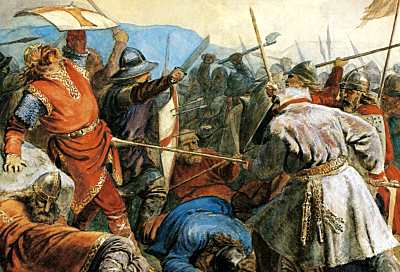 |
In chapter 2 of Hallfreðar saga, it is said that after a long night of drinking, Sóti and his men went up to the loft to retire for the night. Óttar and Ávaldi broke in to the house to fight. Óttar thrust his sword up under Sóti's mail shirt, into his gut, killing him. An interesting aspect of this episode is that Sóti was wearing mail while drinking at night in his farm house. One wonders why he felt a need to wear mail in this situation.
There are a number of interesting examples in the sagas in which men chose not to use mail, even though it was available to them, such as in chapter 19 of Grettis saga. While preparing to defend the household from twelve vikings, Grettir grabbed a spear, sword, and helmet, but left behind a mail shirt.
http://www.hurstwic.org/history/articles/manufacturing/text/viking_...
Tags:
Replies to This Discussion
Events
-
2014 is the Chinese Year of the Horse
February 17, 2026 at 12am to February 5, 2027 at 12am – where & how you choose
Birthdays
Birthdays Today
Birthdays Tomorrow
Important (read & understand)
Skype: Travelingraggyman
Email and Instant Messenger:
TravelerinBDFSM @ aol/aim; hotmail; identi.ca; live & yahoo
OR
Travelingraggyman @ gmail and icq ***

1AWARD UPDATES & INFORMATION
10,000 votes - Platinum Award
5,000 votes - Gold Award
2,500 votes - Silver Award
1,000 votes - Bronze Award
300 votes - Pewter Award
100 votes - Copper Award
Member of the Associated Posting System {APS}
This allows members on various sites to share information between sites and by providing a by line with the original source it credits the author with the creation.
Legal Disclaimer
***************We here at Traveling within the World are not responsible for anything posted by individual members. While the actions of one member do not reflect the intentions of the entire social network or the Network Creator, we do ask that you use good judgment when posting. If something is considered to be inappropriate it will be removed
Site Meter
This site is strictly an artist operational fan publication, no copyright infringement intended
Patchwork Merchant Mercenaries had its humble beginnings as an idea of a few artisans and craftsmen who enjoy performing with live steel fighting. As well as a patchwork quilt tent canvas. Most had prior military experience hence the name.
Patchwork Merchant Mercenaries.
Vendertainers that brought many things to a show and are know for helping out where ever they can.
As well as being a place where the older hand made items could be found made by them and enjoyed by all.
We expanded over the years to become well known at what we do. Now we represent over 100 artisans and craftsman that are well known in their venues and some just starting out. Some of their works have been premiered in TV, stage and movies on a regular basis.
Specializing in Medieval, Goth , Stage Film, BDFSM and Practitioner.
Patchwork Merchant Mercenaries a Dept of, Ask For IT was started by artists and former military veterans, and sword fighters, representing over 100 artisans, one who made his living traveling from fair to festival vending medieval wares. The majority of his customers are re-enactors, SCAdians and the like, looking to build their kit with period clothing, feast gear, adornments, etc.
Likewise, it is typical for these history-lovers to peruse the tent (aka mobile store front) and, upon finding something that pleases the eye, ask "Is this period?"
A deceitful query!! This is not a yes or no question. One must have a damn good understanding of European history (at least) from the fall of Rome to the mid-1600's to properly answer. Taking into account, also, the culture in which the querent is dressed is vitally important. You see, though it may be well within medieval period, it would be strange to see a Viking wearing a Caftan...or is it?
After a festival's time of answering weighty questions such as these, I'd sleep like a log! Only a mad man could possibly remember the place and time for each piece of kitchen ware, weaponry, cloth, and chain within a span of 1,000 years!! Surely there must be an easier way, a place where he could post all this knowledge...
Traveling Within The World is meant to be such a place. A place for all of these artists to keep in touch and directly interact with their fellow geeks and re-enactment hobbyists, their clientele.
© 2024 Created by Rev. Allen M. Drago ~ Traveler.
Powered by
![]()
